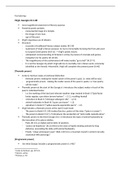Fred Spierings
Virgil, Georgics III.1-48
most magnificent statement of literary purpose
Powerful poetic symbols:
- monumental image of a temple,
- the image of one man,
- ego of the poet.
Virgil’s ingenious use of allusion
Structure:
- recusatio of traditional literary subject matter (III.3-8)
- statement of Virgil’s literary purpose: to rise to immortality by being the first Latin poet
to surpass Greek poetry (III.8-11) -> Virgil’s poetic victory
- anticipated commemorating of Octavian’s victory by means of a temple and games,
metaphors for his poetry (III.10-36).
- The magnificence of this achievement will make Inuidia “go to hell” (III.37-9).
- It is not the Georgics by which Virgil will rise to mortality, but a future work, commonly
identified as the Aeneid. Meanwhile, Virgil will complete the present poem (III.40)
[Thematic proem]
Conte & Harrison make a functional distinction:
- thematic proem: making the reader aware of the poem’s quid, i.e. what will be said,
- programmatic proem: making the reader aware of the poem’s quale, i.e. how poetry
will be made.1
Thematic proem at the start of the Georgics I: introduces the subject matter of each of the
poem’s individual books:
- i.e. the working of the land and relevant weather sings treated in Book I (“Quid faciat
laetas segetes, quo sidere terram/vertere” – I.1-2.; recalling Hesiod)
- viniculture in Book II (“ulmisque adiungere vitis” – I.2-3)
- animal husbandry in Book III (“quae cura boum” – I.3)
- apiculture in book IV (“apibus quanta experientia parcis” – I.4).
Virgil includes a thematic proem at the start if each book:
- The poem to Book II (II.1-8) invokes Bacchus, patron of the vines (“pater o Lenaee”)
- The proem to Book IV (IV.1-7) introduces the production of “aërii mellis caelestia dona”.
Thematic proem to the third Georgic (III.1-2) introduces the topic of animal husbandry by
the invocation of its patron deities:
- Pales (III.1) is an Italian patron deity of pastores.
- “pastor ab Amphryso” (III.2) refers to the story of Apollo tending animals for king
Admetus, associating the deity with animal husbandry.
- Finally, “siluae amnesque Lycaei” (Ibid.) refers to a mountain massif in western Arcadia
associated with pasturage.2
[Programmic proem]
the third Georgic includes a programmatic proem (I.1-48). 3
1
Conte & Harrison, pp. 219-21.
2
Mynors, ad loc.
3
Thomas, p. 92.
, Thematic proem was a common feature of Greek poetry dating back to Homer
The programmatic proem is an Hellenistic invention -> Conte & Harrison:
- professionalism and, correspondingly, the learned audience to which the libraries, courts
and schools of the Hellenistic age gave rise.
- intellectual climate -> “literature is no longer something obvious: whoever practises it
must say what he is doing [i.e. the aforementioned quale, or literary purpose], because
everyone does it differently.”4
- Especially Callimachus’ programmatic proem to the Aetia was of great influence to
Virgil’s programmatic proem to the third Georgic.
[Proem in the middle]
Callimachus’ programs proem was located where one would expect a proem, namely at the
start of his work
Virgil’s programmatic proem is located in the middle of the Georgics, at the beginning of the
second half.
A program proem in the middle occurs in several works of Latin poetry:
- first found at the start of book 7 of Ennius’ Annals
- Conte & Harrison: this Roman invention points at the poet’s “awareness of the
difference in functionality between (…) “the ancient proem of contents and the
programmatic proem, Alexandrian and modern.” 5
- Allows Virgil to separate the statement of his quid from the statement of his quale.
- Lucretius introduced the subject matter of his poetry at the start of DRN book I, while he
states his literary program at a latter point, possibly right at the middle of his poem at
start of book IV.
NOTE that the programmatic proem to DRN book IV (1-25) repeats lines I.926–50. It
is unclear whether this repetition is intentional and, if not, where Lucretius originally
placed these lines.
[Recusatio]
Virgil’s programmatic proem commences with a recusatio.
The poet speaks of literary topics which are “omnia iam uulgata” (III.4):
- underscored by “quis (…) nescit” (III.4-5) and “dictus” (III.6)
- Eurystheus, Busiris and Hylas (III.4-6) are characters associated with Hercules’ labours.
- “Lationia Delos” (III.6) refers to the birth of Apollo on Delos.
- Pelops won Hippodamia in a chariot race (III.7).
In the context of trite poetry, they may be conceived of as simply representing the
traditional topics of Greek poetry:
- Hercules’ (or any hero’s) labours
- the birth of deities
- Contests
Virgil draws much of the programmatic imagery of the proem to the third Georgics from
Callimachus and Pindar -> in this light, Virgil’s recusatio recalls Callimachus and Pindar
(possible) Callimachean allusions:
- “omia iam uulgata” (III.4), the object of Virgil’s recusatio, echoes “πάντα τὰ δημόσια”,
the object of Callimachus’ recusatio in Epigram 28 (28.4).
4
Conte & Harrison, pp. 219-21.
5
Id., p. 228.




